Dive Brief:
- Nashville, TN is conducting a flight survey that uses laser sensors and aerial images to estimate how much of the city is covered by tree canopy, according to Tennesseean. Leaders will use the results to come up with a plan for preventing more tree loss and planting new vegetation.
- The number of trees in Nashville has been declining as the city's population booms. Trees are being cleared to make way for developments to serve the increasing number of residents.
- The last Tree Canopy Assessment took place in 2008 and the report was published in 2010, before Nashville's population and development surge.
Dive Insight:
The last Tree Canopy Assessment estimated that metro Nashville had 47% urban tree canopy (UTC), and it suggested that maintaining or increasing UTC can be achieved through public-private partnerships that promote tree planting and enforce tree-related ordinances. It recommended another UTC assessment in five to eight years to check on development and whether tree retention measures are effective.
The U.S. Census Bureau estimates that the Nashville metropolitan area's population grew by an average of more than 32,000 people a year from 2010 to 2016, which is a more than 11% bump in the number of residents. While the increase has helped the city economically, it has hurt its vegetation as developers clear land to build new homes and businesses. The new tree survey will help city leaders quantify exactly how much tree cover has disappeared and how to curb tree loss.
Last year, Mayor Megan Barry gathered stakeholders from a number of sectors to form the Livable Nashville Committee. Earlier this year the committee released its recommendations for improving the city's livability and environmental quality, covering areas such as transportation, waste reduction and greenhouse gas emissions reduction. One of the strategies for reducing hazardous air quality harnesses the idea that urban greening reduces pollution and improves public health. It called for an increase in tree canopy cover from 47% to 50% by 2050.
To achieve the canopy cover goal, tree loss would have to stop and more than 20,000 trees would have to be planted each year until 2050. That in itself is an aggressive goal — both financially and in concept execution — and it doesn't even take into account that Nashville's UTC is likely lower right now than the previously listed 47% because of the city's population and development boom. While achieving the 50% UTC goal by 2050 is possible, it will take a significant amount of effort from the municipal government. Leaders will need to transform the data they receive from the new tree canopy assessment into aggressive, concrete plans for turning around Nashville's current tree loss.










